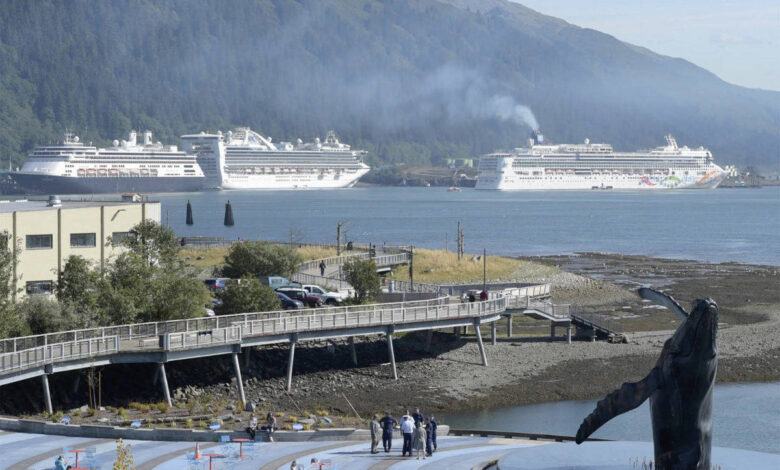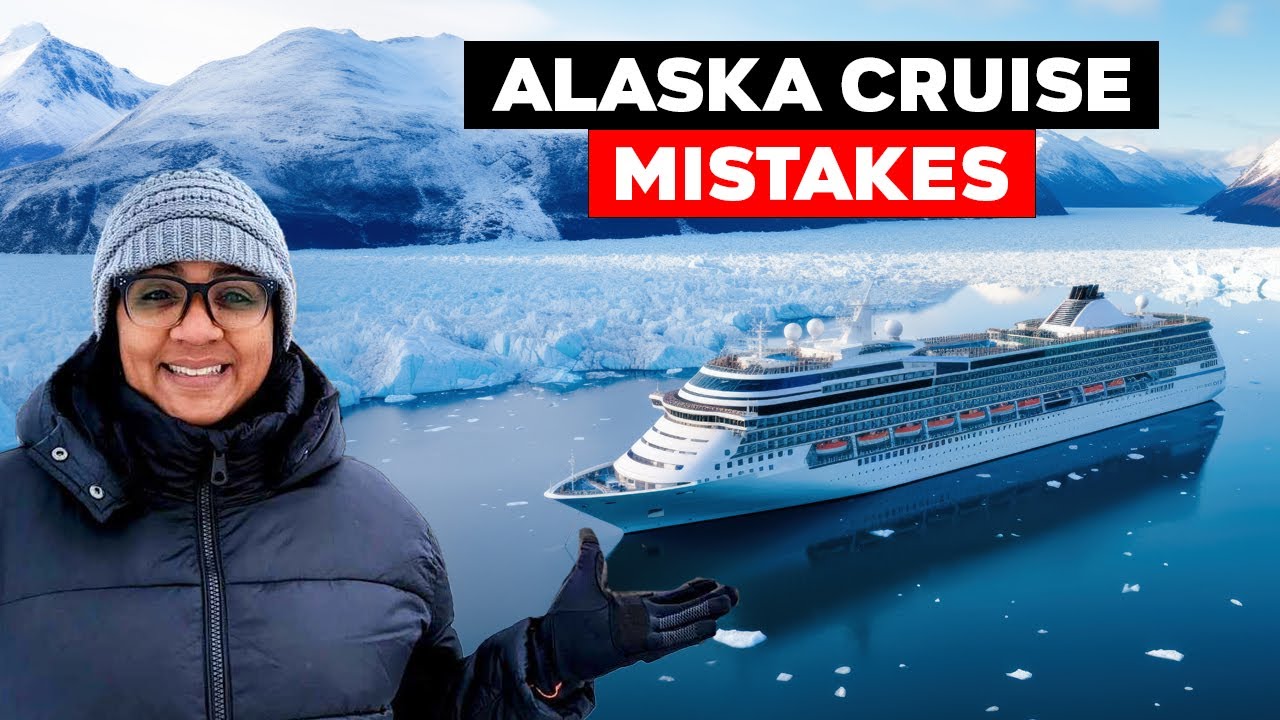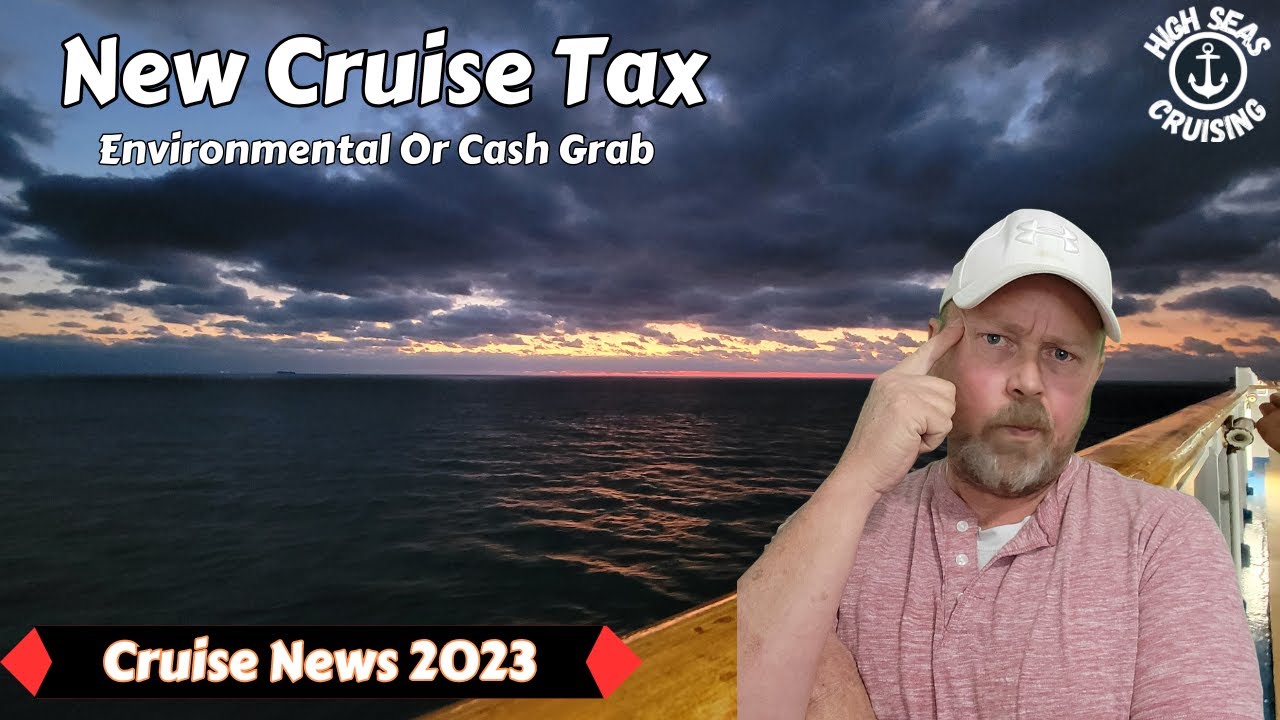
Alaska Cruise Passenger Tax Legal Standing
Alaska maintains that tax on cruise passengers is legal, sparking debate about its justification and potential impact. This in-depth exploration delves into the legal arguments, constitutional considerations, economic implications, and public perspectives surrounding this controversial tax.
The state’s claims rest on a detailed analysis of the legal basis, encompassing specific statutes and regulations. However, potential counterarguments and constitutional challenges are also carefully examined. The scope of the tax, its application to various cruise activities and lines, and the economic ramifications for both the cruise industry and Alaska itself are all crucial elements of this discussion.
Legal Basis of the Tax

Alaska’s justification for the cruise passenger tax rests on its authority to levy taxes on activities that generate revenue within the state. The tax is designed to fund specific projects and initiatives aimed at offsetting the impacts of cruise tourism on Alaska’s infrastructure and communities. This complex issue involves interpreting state constitutional powers and how those powers apply to the unique economic environment of cruise ship activity.Alaska argues that the tax is a legitimate exercise of its taxing power, targeting a specific economic activity impacting the state.
This activity generates revenue and requires public resources to support. The tax is not simply a fee for entry or use of state facilities, but a levy on a commercial enterprise that benefits from the state’s resources.
Specific Legal Arguments and Supporting Evidence
Alaska’s legal arguments for the tax are multifaceted, drawing on various legal precedents and state statutes. The tax is not simply a fee, but a levy on the revenue generated by a commercial enterprise.
| Argument | Supporting Evidence | Potential Counterarguments |
|---|---|---|
| Taxation of Economic Activity Within State Borders | Alaska’s constitution and various statutes grant the state the power to tax activities and enterprises operating within its borders. Cruise ships, though not docked permanently, generate substantial economic activity within Alaskan waters, including port calls, purchases, and spending by passengers. | Opponents might argue that the tax is an improper burden on interstate commerce, or that the cruise ships’ primary activity is outside Alaskan waters, thus diminishing the state’s jurisdiction to tax. |
| Nexus and Sufficient Connection | The state argues that there’s a sufficient connection between the cruise passengers’ activities and Alaska. This connection includes the use of Alaskan ports, infrastructure, and the generation of revenue that impacts local communities. This argument is further supported by the volume of activity generated by cruise ships within the state’s waters. | Potential counterarguments might focus on the transient nature of cruise passengers, claiming a lack of direct and sustained connection to the state, arguing that the majority of economic activity happens outside Alaska’s borders. |
| Regulation of Commerce | Alaska’s ability to regulate commerce within its borders, as granted by state law, is another supporting pillar for the tax. This regulation, within reasonable limits, applies to commercial activities, including cruise operations. | Critics might contend that the tax is overly burdensome on interstate commerce and violates principles of uniformity in taxation. They may also argue that the tax is discriminatory against cruise passengers compared to other tourists. |
Comparison with Potential Counterarguments
The legal arguments for the tax are framed around the principle of state sovereignty and the ability to regulate activities that impact the state. However, opponents often cite principles of interstate commerce and the transient nature of cruise ship passengers. The debate centers on the extent of Alaska’s jurisdiction over cruise ship activity, particularly when the primary economic activity occurs outside the state’s borders.
The key to resolving the legal dispute is to weigh the state’s interest in taxing activities within its jurisdiction against the potential burdens on interstate commerce and the rights of out-of-state entities.
Constitutional Considerations
Alaska’s cruise passenger tax, while seemingly straightforward, faces scrutiny under various constitutional principles. The tax’s legality hinges on its adherence to the Constitution, specifically concerning issues of taxation, commerce, and due process. Understanding these potential challenges is crucial for assessing the tax’s long-term viability.This analysis delves into the constitutional principles that might be invoked to challenge the tax, the potential arguments against its constitutionality, and how existing court precedents could shape the outcome of such a challenge.
A comprehensive understanding of these factors is essential for a thorough evaluation of the tax’s legal standing.
Potential Constitutional Challenges
The tax’s constitutionality is potentially challenged on multiple fronts, each stemming from distinct constitutional provisions. These challenges may include claims of improper taxation, undue burden on interstate commerce, and violations of due process.
- Taxation Clause Challenges: The tax’s validity under the taxing power of the state is a primary concern. A challenge could center on whether the tax is levied fairly and uniformly. A lack of a discernible nexus between the cruise passengers and Alaska’s interest could be raised, for example, if the tax disproportionately affects passengers with no direct connection to the state beyond their visit.
The Supreme Court’s precedents on state taxation of interstate commerce are vital to evaluating this challenge. Arguments against the tax’s constitutionality could include that the tax lacks a substantial nexus with the activity being taxed and may be considered discriminatory.
- Commerce Clause Challenges: The tax may be deemed to place an undue burden on interstate commerce. If the tax is shown to substantially affect or discriminate against interstate commerce, the state’s power to tax is potentially limited. Arguments against the tax’s constitutionality could center on the idea that it creates an unnecessary burden on cruise lines and passengers, thereby disrupting the free flow of interstate commerce.
- Due Process Clause Challenges: The tax may also face challenges under the Due Process Clause. This clause safeguards individuals from arbitrary government action. A potential argument against the tax’s constitutionality could involve claims that the tax is imposed without sufficient notice or opportunity to be heard, or that it violates the principle of fairness and equality.
Impact of Court Precedents
Several Supreme Court cases have shaped the interpretation and application of the taxing power and the commerce clause. These precedents offer valuable insight into how courts may rule on the Alaskan cruise passenger tax. Cases involving state taxation of interstate commerce, like Complete Auto Transit, Inc. v. Brady, are crucial in evaluating the potential constitutionality of the tax. The court’s interpretations in these precedents set the stage for arguments against the tax.
- Complete Auto Transit, Inc. v. Brady (1977): This case established the “substantial nexus” test, requiring a significant connection between the taxed activity and the taxing state. The lack of such a nexus could be a significant factor in a challenge to the cruise passenger tax.
- Quill Corp. v. North Dakota (1992): This case clarified the limitations on state taxation of businesses not physically present within the state. The implications for taxing cruise passengers, who may not have a physical presence in Alaska, warrant consideration. Similar precedents, such as those concerning sales taxes imposed on out-of-state businesses, can be examined to assess the validity of Alaska’s tax.
Arguments Against the Tax’s Constitutionality
Potential arguments against the tax’s constitutionality could focus on the lack of a substantial nexus between the taxed activity (cruise passengers) and the taxing state (Alaska). These arguments could also include claims that the tax disproportionately affects interstate commerce, or that it violates the principle of due process. These arguments are directly tied to the legal precedents discussed.
In essence, arguments would seek to demonstrate that the tax exceeds the permissible bounds of state taxation under the Constitution.
Scope and Application of the Tax
Alaska’s cruise passenger tax is designed to generate revenue for state programs, while also ensuring a fair and equitable distribution of the cost among all participants. This tax aims to capture a portion of the economic activity generated by cruise tourism, which directly benefits the state. Understanding its scope and application is crucial for both cruise lines and passengers alike.The tax’s application is carefully crafted to encompass a wide range of cruise activities and passenger types, while remaining consistent with legal and ethical considerations.
This detailed approach ensures that the tax is properly levied and collected, contributing to the financial stability of Alaska’s programs.
Definition of Scope
The tax applies to all cruise passengers disembarking in Alaskan ports. This includes passengers who are on day trips, multi-day excursions, or passengers on overnight stays. Crucially, the tax applies regardless of the passenger’s nationality or residency status.
Methods for Calculating Tax Amount
The tax is levied based on a per-passenger, per-day rate. The calculation is straightforward, allowing for transparent assessment.
Tax Amount = Per-Passenger Rate x Number of Days in Port
The per-passenger rate is fixed by the state legislature and is periodically reviewed.
Application to Various Cruise Activities
The tax applies uniformly to all cruise activities, regardless of the specifics of the cruise line’s itinerary. Whether passengers are engaging in sightseeing, shore excursions, or simply relaxing on the ship, the tax applies. This ensures that all cruise activities contribute to the state’s revenue.
Application to Different Cruise Lines and Itineraries
The tax applies to all cruise lines operating in Alaskan waters. The tax does not differentiate between large or small cruise lines, or between short-duration or long-duration itineraries. For example, a 3-day cruise to Glacier Bay National Park would be subject to the same tax as a 7-day cruise visiting multiple Alaskan ports. This ensures consistency and fairness in the tax application across all cruise operators and itineraries.
Examples of Tax Application
- A passenger on a 2-day cruise visiting Seward, Alaska, who disembarks and spends the day exploring the town is subject to the tax.
- A passenger on a 5-day cruise that calls on multiple Alaskan ports, spending time at each location, is also subject to the tax for each day they spend in port.
Economic Impact Analysis

Alaska’s proposed tax on cruise passengers presents a complex economic equation. While proponents highlight potential revenue streams, the potential consequences for the cruise industry, passenger numbers, and overall Alaskan tourism must be carefully considered. Understanding these impacts is crucial for a comprehensive evaluation of the tax’s long-term viability and fairness.The cruise industry is a significant player in Alaska’s economy, contributing to jobs and revenue across multiple sectors.
A tax on cruise passengers, while potentially generating substantial funds for the state, could alter this dynamic in unforeseen ways. The interplay between passenger demand, cruise line profitability, and the state’s overall tourism picture will be critical to monitor.
Impact on Cruise Lines
The tax’s impact on cruise lines is multifaceted and potentially substantial. Cruise lines will likely absorb some of the tax in ticket prices, potentially impacting passenger demand. The increased cost could lead to fewer passengers opting for Alaskan cruises, thus reducing revenue for the cruise lines themselves.
- Price Adjustments: Cruise lines may adjust ticket prices to compensate for the tax, potentially making Alaskan cruises less attractive to budget-conscious travelers. This could lead to a decrease in overall passenger numbers.
- Route Adjustments: Some cruise lines might reconsider Alaskan itineraries if the tax significantly impacts their profitability. This could negatively affect Alaska’s tourism industry by reducing the variety of cruise options available.
- Reduced Investment: If cruise lines perceive the tax as unsustainable or unfavorable, they may reduce investment in Alaskan ports and related infrastructure, potentially hindering future tourism development.
Potential Effects on Passenger Numbers
Predicting the exact impact on passenger numbers is challenging, but several factors are worth considering. A tax increase could directly influence the decision-making process of potential tourists, leading to fewer bookings.
- Shifting Passenger Preferences: Higher prices could incentivize travelers to seek alternative destinations or vacation options, such as land-based tours or other cruise destinations with lower costs. Examples exist of similar taxes negatively impacting passenger numbers in other destinations.
- Reduced Tourism Spending: Fewer passengers translates to less spending on lodging, food, and activities in Alaskan communities, potentially impacting the local economy beyond the cruise industry.
- Impact on Tourism Revenue: The overall tourism revenue generated from cruise tourism might decrease, thus impacting the state’s fiscal outlook.
Economic Consequences for Alaska
The economic consequences for Alaska are complex and interconnected. The state’s economy relies heavily on tourism, and a decline in cruise tourism could have far-reaching effects.
Alaska’s stance on the cruise passenger tax is drawing a lot of attention, with the state maintaining it’s legal. Meanwhile, it’s inspiring to see so many young leaders stepping up, like the dozens of graduates honored at a transformational leadership ceremony, celebrating the future of leadership. Ultimately, the debate over the tax highlights the complex interplay between tourism and local economies, much like the dedication of these inspiring graduates.
- Job Losses: Reduced cruise passenger numbers could lead to job losses in related sectors, such as hospitality, transportation, and retail, potentially causing unemployment and financial hardship for Alaskan families.
- Reduced State Revenue: While the tax is intended to generate revenue, a decrease in cruise passenger numbers could result in lower tax revenues than initially anticipated. This could impact funding for crucial state services.
- Diminished Economic Growth: A decline in cruise tourism could stifle economic growth in Alaska, potentially impacting its long-term prosperity and competitiveness in the tourism market.
Comparing Potential Benefits and Drawbacks
| Potential Benefit | Potential Drawback |
|---|---|
| Increased revenue for the state | Potential decrease in cruise passenger numbers |
| Funding for state services | Reduced tourism revenue for Alaskan businesses |
| Support for Alaskan communities | Shift in passenger preference to alternative destinations |
| Potential for economic growth | Negative impact on cruise line profitability |
Public Opinion and Stakeholder Perspectives
The Alaskan cruise passenger tax has ignited a passionate debate, pitting the potential revenue gains against the concerns of various stakeholders. Public opinion is sharply divided, reflecting the complex interplay of economic benefits and potential burdens. Understanding the perspectives of cruise lines, tourism boards, and local businesses is crucial for a balanced assessment of the tax’s impact.
Public Opinion on the Tax
Public opinion regarding the tax is multifaceted, ranging from strong support for its revenue-generating potential to vehement opposition due to its perceived impact on the cruise industry and local economies. Proponents highlight the potential for increased funding of vital state services, such as infrastructure development or education initiatives. Conversely, opponents argue that the tax will deter tourists, harm local businesses, and negatively affect Alaska’s image as a tourist destination.
A variety of factors influence individual viewpoints, including personal financial situations, perceived fairness of the tax, and their level of engagement with the cruise industry.
Cruise Line Perspectives
Cruise lines are a key stakeholder group, directly affected by the tax. They anticipate reduced passenger numbers and potentially higher ticket prices as a consequence. Many cruise lines are concerned that the tax will disproportionately affect their business, potentially impacting their profitability and future investment in Alaskan ports. Furthermore, they may consider shifting their operations to destinations with less stringent taxation.
Increased costs for cruises might translate into reduced demand from travelers.
Tourism Board Perspectives
Tourism boards are crucial for maintaining Alaska’s appeal to tourists. They often advocate for policies that support and encourage tourism. However, they also recognize the potential negative impacts of the tax on the cruise industry and overall tourism. Their perspectives frequently incorporate data on the potential effects on visitor numbers, and their statements reflect a balanced approach that aims to maximize tourism while mitigating any potential negative effects of the tax.
Tourism boards frequently conduct surveys to gauge the public perception of the tax.
Local Business Perspectives
Local businesses, including restaurants, hotels, and shops that rely on cruise ship passengers, are significantly impacted by the tax. They anticipate a decline in revenue if the tax discourages cruise tourism. Local businesses are often concerned about the ripple effects of the tax on their employees and the overall economy. These businesses might have to absorb the increased costs of the tax or cut their staff, thus affecting local employment.
Summary of Stakeholder Perspectives
| Stakeholder | Perspective | Potential Impact |
|---|---|---|
| Cruise Lines | Concerned about reduced passenger numbers, increased costs, and potential shift in operations. | Potential decline in cruise ship traffic and economic impact on related industries. |
| Tourism Boards | Recognizing the potential negative impacts on the cruise industry but also the need for increased state funding. | Possible decline in overall tourism revenue and potential negative effects on local businesses. |
| Local Businesses | Anticipate a decline in revenue due to reduced cruise ship passengers. | Decreased income for businesses, potential job losses, and negative ripple effect on the local economy. |
| General Public | Divided opinions; proponents highlight funding opportunities, while opponents express concern about potential economic repercussions. | Difficult to predict the overall impact on public opinion and support for the tax. |
Historical Context and Similar Cases: Alaska Maintains That Tax On Cruise Passengers Is Legal
Alaska’s cruise passenger tax, a relatively recent addition to the state’s revenue streams, sits within a broader landscape of tourism-related taxation. Understanding its history, and how it compares to other jurisdictions, provides crucial context for assessing its legality and impact. This analysis delves into the historical development of such taxes, highlighting similarities and differences with existing practices in other regions.The Alaska cruise passenger tax is a relatively new development, arising in response to the growing importance of cruise tourism to the state’s economy.
While the exact timing of its introduction is crucial, it’s important to understand the evolution of cruise tourism taxation in Alaska to contextualize the tax’s position within the state’s broader fiscal landscape. This includes identifying any prior attempts at taxing cruise passengers and how the current tax is different.
Historical Development of Cruise Passenger Taxes
Alaska’s cruise passenger tax is a relatively recent development. Its introduction is likely tied to a rise in cruise ship traffic to Alaska and a desire to generate revenue to offset the costs associated with managing this tourism sector. Historical data on the number of cruise passengers visiting Alaska, and the revenue generated from the tax, would strengthen the analysis.
Comparison with Similar Taxes in Other Jurisdictions
Several jurisdictions around the world have implemented taxes on tourists, though the specifics vary significantly. Comparing Alaska’s tax with similar levies in other regions provides a valuable comparative analysis. The tax rates, exemptions, and revenue generation of similar taxes in countries like the Caribbean, or those with significant cruise ports in Europe, would offer a clearer perspective.
Relevant Legal Precedents and Similar Cases, Alaska maintains that tax on cruise passengers is legal
Examining legal precedents regarding similar taxes on tourists is crucial to understanding the legal basis of Alaska’s tax. A detailed review of court cases, or administrative rulings, where taxes on tourists have been challenged or upheld, is vital. This review should specifically examine whether the legal arguments used in these cases are applicable to Alaska’s situation, including the constitutional arguments presented and the courts’ decisions.
The criteria used by courts to determine the legality of tourist taxes should be explored.
Key Similarities and Differences with Other Cases Related to Taxes on Tourists
Identifying similarities and differences with other cases related to taxes on tourists is essential. This comparison should include a review of the constitutional arguments raised in these cases and how they align or diverge from the arguments in the Alaska case. A table summarizing the key similarities and differences, including the legal arguments, outcomes, and jurisdictions, would enhance the analysis.
Alaska’s claim that the tax on cruise passengers is legal is interesting, but what about the onboard experience? Aboard the Regal Princess, the atrium and spa are front and center here , highlighting the cruise line’s focus on luxurious amenities. Ultimately, the legality of the tax still hinges on broader factors, regardless of the ship’s impressive features.
| Jurisdiction | Tax Type | Legal Arguments | Outcome |
|---|---|---|---|
| Example Jurisdiction 1 | Example Tax | Example Argument 1, Example Argument 2 | Example Outcome |
| Example Jurisdiction 2 | Example Tax | Example Argument 1, Example Argument 2 | Example Outcome |
Potential Dispute Resolution Mechanisms
Navigating the complexities of a new tax often leads to disputes. Understanding the avenues for challenging a tax, whether through administrative appeals or legal action, is crucial for both taxpayers and the governing body. This section details the potential dispute resolution processes available for parties challenging Alaska’s cruise passenger tax.Dispute resolution processes are designed to provide a structured path for addressing disagreements and upholding fairness in tax matters.
These processes vary based on the nature of the dispute and the specific regulations governing the tax.
Alaska’s stance on the cruise passenger tax is interesting, claiming it’s perfectly legal. However, the way cruise lines advertise and market their destinations, particularly through the pioneer online travel agencies like advertising and the pioneer otas , might have a significant impact on whether or not this tax is perceived as fair by passengers. Ultimately, the legality of the tax likely boils down to the specific details of the legislation, but these marketing tactics are worth considering when analyzing the entire picture.
Legal Avenues for Challenging the Tax in Court
Legal challenges to the tax can be initiated through various court proceedings, typically based on constitutional violations, statutory interpretation, or procedural errors. These challenges require careful legal strategy and adherence to established court procedures.
- Constitutional challenges often center on claims that the tax violates fundamental rights, such as due process or equal protection. These claims necessitate demonstrating a clear link between the tax and the alleged constitutional violation.
- Statutory interpretation challenges focus on the precise wording of the law. The interpretation of the law, particularly concerning the tax’s application, can become a point of contention. Arguments may focus on whether the tax is clearly defined, applied consistently, or whether it conflicts with other existing legislation.
- Procedural challenges highlight irregularities in the tax collection process. For example, a taxpayer might argue that the tax was improperly assessed, that they were not adequately notified, or that the tax collection method was not in accordance with established procedures. This often involves demonstrating a specific procedural error that harmed the taxpayer’s rights.
Administrative Procedures for Appealing the Tax
Prior to pursuing legal action, administrative appeals offer a less adversarial pathway for resolving disputes. These appeals often involve specific deadlines and procedural requirements Artikeld in the tax regulations.
- Taxpayers have a specified time frame for filing appeals. These deadlines are often critical to the appeal’s success, and it is vital to adhere to them. A clear timeline is essential to avoid delays or potential rejection of the appeal.
- Appeals are typically submitted to a designated administrative body, such as a tax board or commission. This body is responsible for reviewing the appeal, gathering evidence, and making a decision.
- Appeals often involve submitting documentation supporting the taxpayer’s position. This might include supporting evidence, such as financial records or legal precedents. The clarity and completeness of this documentation can significantly influence the outcome of the appeal.
Flowchart of Potential Steps in Challenging the Tax
The following flowchart illustrates the potential steps a party might take when challenging the tax:“`[Diagram](Start) –> [Assess Tax] –> [Receive Tax Bill] –> [Review Tax Bill] –> [Identify Dispute] –> [Contact Tax Authority] –> [Administrative Appeal (if applicable)] –> [Court Action (if applicable)] –> [Outcome] –> (End)[Explanation]The flowchart demonstrates a potential sequence of steps. The key is to follow the established procedures diligently.
Early engagement with the tax authority can potentially resolve the dispute without resorting to formal legal action.“`
Alternatives to the Tax
Alaska’s reliance on the cruise passenger tax raises concerns about its long-term sustainability and potential negative impacts on tourism. Exploring alternative revenue streams is crucial for ensuring the state’s financial stability and maintaining a healthy economy. Diversifying funding sources can reduce the vulnerability of the state budget to external factors like fluctuating tourism numbers or economic downturns.The state’s budget is intricate and affected by multiple factors.
Implementing new revenue streams requires careful consideration of their potential effects on various sectors of the economy, as well as on Alaska’s residents. Understanding the potential impacts of different funding strategies allows for informed decision-making and promotes responsible fiscal management.
Potential Revenue Sources
Alaska possesses a wealth of natural resources and a diverse economy, offering several avenues for generating revenue beyond the cruise passenger tax. Examining these options can lead to more sustainable and resilient funding mechanisms.
- Increased Taxation on Natural Resources: A potential revenue stream lies in adjusting taxation policies related to the extraction and processing of Alaska’s natural resources. This approach could generate substantial income, but it also needs to consider potential environmental consequences and the impact on local communities. The specific tax rates and regulations would require careful analysis and public input to balance revenue generation with environmental protection and social equity.
Alaska’s claim that the tax on cruise passengers is legal is interesting, considering the recent news about Aker Yards. Their name change, as detailed in this article about aker yards name goes away , raises questions about legal precedents and financial impacts. Regardless, Alaska’s position on the cruise passenger tax remains a topic of debate.
- Investment in Renewable Energy: Alaska’s vast potential for renewable energy, including wind and solar power, can be leveraged to create new revenue streams and reduce reliance on fossil fuels. Investment in infrastructure for renewable energy generation and distribution could create jobs and contribute to the state’s long-term energy security. The transition to renewable energy would require significant upfront investment but could yield long-term economic and environmental benefits.
- Tourism Diversification: Alaska’s tourism sector is not limited to cruise ships. Promoting alternative tourism activities, such as outdoor recreation, wildlife viewing, and cultural experiences, can generate diverse revenue streams. This approach requires targeted marketing and investment in infrastructure to cater to different types of tourists and ensure that the revenue is equitably distributed throughout the state.
- Economic Development Incentives: Attracting new businesses and industries to Alaska can boost the economy and generate tax revenue. Providing incentives, such as tax breaks or infrastructure support, can stimulate economic growth and create job opportunities. These incentives should be carefully designed to maximize economic benefit and minimize potential downsides, such as undue burden on existing businesses.
- Increased State Lottery Revenue: Increasing the revenue generated by state lotteries could be a relatively straightforward way to increase funding for state services. However, this option could raise ethical concerns regarding responsible gambling and potentially disproportionate impact on low-income communities.
Potential Funding Approaches
Beyond exploring new revenue streams, alternative approaches to funding state needs should also be considered. These approaches could include a shift in spending priorities or more effective resource allocation.
- Prioritizing Budget Allocation: A detailed review of the state’s budget, identifying areas where spending could be reallocated or reduced, could generate substantial savings. For example, scrutinizing existing programs and identifying potential redundancies or inefficiencies can lead to optimized resource allocation and reduce unnecessary expenditures.
- Investing in Infrastructure Projects: Investing in strategic infrastructure projects can have long-term economic benefits for Alaska. These projects could include improvements to transportation networks, communication systems, or energy infrastructure. Careful planning and evaluation of project feasibility and impact on various sectors of the economy are essential.
- Partnerships with the Federal Government: Alaska can explore potential partnerships with the federal government to secure funding for critical infrastructure projects or to address shared challenges. This requires a proactive approach to identifying opportunities for collaboration and effectively advocating for Alaska’s needs.
Impact on the State Budget
The implementation of any alternative revenue source or funding approach will have an impact on the state’s budget. Forecasting these impacts is crucial to understanding the long-term implications and to make informed decisions.
| Alternative | Potential Budget Impact | Considerations |
|---|---|---|
| Increased Natural Resource Taxation | Potentially significant increase in revenue, but with environmental and social costs | Need to consider environmental regulations and social equity |
| Renewable Energy Investments | Initial investment costs, but long-term revenue generation and cost savings | Potential for job creation and energy independence |
| Tourism Diversification | Potential increase in tourism-related revenue, but dependent on successful marketing and infrastructure development | Potential for improved economic diversification |
| Economic Development Incentives | Potential for increased tax revenue and job creation, but requires careful design to maximize benefits | Potential for negative impacts on existing businesses |
Illustrative Case Studies

Digging deeper into the legal landscape surrounding tourist taxes, we find valuable insights in similar cases. Examining past precedents can offer crucial context for understanding potential challenges and outcomes. These precedents, while not identical to Alaska’s situation, provide a framework for interpreting legal arguments and evaluating potential impacts.This section will delve into two specific cases, highlighting their key characteristics and implications.
We will analyze how the legal arguments and outcomes of these cases might apply to Alaska’s proposed tax on cruise passengers.
Alaska’s claim that their cruise passenger tax is legal is interesting, but it’s worth considering the contrasting situation in Jamaica. With winter tourism expected to surge, airlift is clearly a priority for Jamaica. This focus on bolstering air connectivity, as seen in airlift a priority as jamaica confident of winter arrivals boost , highlights the importance of efficient transport links for attracting tourists.
Ultimately, Alaska’s tax still needs careful scrutiny, given the complexities of international travel and tourism revenue.
Case 1: City of New Orleans vs. Tourist Taxes
The City of New Orleans has a long history of levying taxes on tourists. A key aspect of this taxation is its relationship to the city’s infrastructure and services. The city’s ability to collect these taxes has been challenged, but ultimately upheld. This case highlights the legal considerations around the financial burden on tourists versus the perceived benefit to the city.
- The legal arguments focused on the city’s authority to impose taxes on non-residents. This included exploring the justification for the tax based on the revenue generated to support the city’s infrastructure and amenities. Furthermore, it addressed the potential for double taxation and the impact of tourism on the local economy.
- The outcome involved a court ruling supporting the city’s right to impose the tax, recognizing the city’s responsibility to provide essential services to all residents and visitors. The court considered the impact of tourism on the city’s infrastructure and the need for revenue to maintain public services.
- The implications for Alaska’s case include the potential need to demonstrate a direct correlation between the tax and the benefits received by cruise passengers and the wider Alaskan community. This could involve showcasing improved infrastructure or services specifically attributable to the tax revenue.
Case 2: State of Florida vs. Visitor Impact Fees
Florida, known for its vibrant tourism industry, utilizes visitor impact fees. These fees are designed to fund improvements in the state’s tourism infrastructure. A central argument revolves around the fairness and effectiveness of the fees in supporting tourism infrastructure.
- Florida’s legal arguments rested on the notion that visitor impact fees are justified as a means to manage and improve infrastructure for the benefit of both residents and tourists. The fees were justified as a direct method to cover costs related to maintaining parks, roads, and other tourist attractions.
- The outcome of these cases typically involves courts upholding the state’s right to impose these fees, provided the fees are demonstrably linked to providing services directly benefiting visitors. This directly relates to the principle of reasonable justification for the tax.
- These cases demonstrate the importance of clear documentation connecting the tax to specific projects or improvements that directly benefit tourists. Alaska would need to provide clear evidence that the tax revenues are used to enhance the cruise passenger experience. This might involve examples like upgrades to port facilities or improved public transportation.
Comparison of Cases
| Feature | New Orleans Case | Florida Case | Alaska Tax Potential |
|---|---|---|---|
| Tax Purpose | Supporting city services | Improving tourism infrastructure | Improving cruise port and related facilities |
| Taxpayer Base | Tourists and residents | Tourists | Cruise passengers |
| Legal Argument | City’s authority to tax non-residents | Justification for fees in support of infrastructure | Connection between tax and benefits for passengers |
| Outcome | Tax upheld | Fees upheld (usually) | Uncertain |
End of Discussion
In conclusion, the legality of Alaska’s cruise passenger tax hinges on a complex interplay of legal arguments, constitutional principles, economic factors, and public opinion. This analysis reveals a nuanced picture, showcasing both the potential benefits and drawbacks of this tax, alongside alternative revenue sources and potential dispute resolution pathways. The future of this tax will depend on careful consideration of all perspectives and the outcome of any potential legal challenges.
FAQ Guide
What are some potential alternative revenue sources for Alaska?
Possible alternatives include increased revenue from non-cruise-related tourism, enhanced resource management, or expanded investments in the state’s infrastructure and technology.
How might the tax affect passenger numbers and tourism revenue?
Potential decreases in passenger numbers and tourism revenue are possible if the tax discourages travel or if cruise lines raise fares to compensate. Conversely, the tax could generate additional revenue for Alaska.
What are the key constitutional principles potentially relevant to this tax?
Constitutional principles relating to taxation, commerce, and due process could be crucial in determining the legality of the tax. Relevant court precedents may also shape the outcome.
What are the potential dispute resolution mechanisms for challenging the tax?
Legal avenues like filing lawsuits, appealing to higher courts, and utilizing administrative procedures are possible avenues for challenging the tax’s legality.






